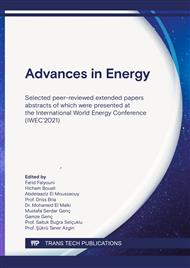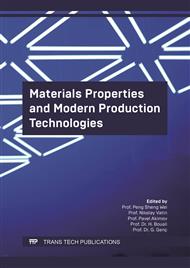[1]
Garnett, E., Mai, L., & Yang, P. Introduction: 1D nanomaterials/nanowires. Chemical reviews, 119(15), 8955-8957. (2019).
DOI: 10.1021/acs.chemrev.9b00423
Google Scholar
[2]
Alt, L. and Reichl, Christian and Berl, Matthias and Dietsche, W. and Wegscheider, W. Gate induced quantum wires in GaAs/AlGaAs heterostructures by cleaved edge deposition, Scientific Reports (2021).
DOI: 10.1038/s41598-021-01130-8
Google Scholar
[3]
Gulyamov, G., Gulyamov, A. G., Davlatov, A. B., & Shahobiddinov, B. B. Electron energy in rectangular and cylindrical quantum wires. (2020).
Google Scholar
[4]
Lei, C., Khalsa, G., Du, J., & MacDonald, A. H. Majorana zero modes in a cylindrical semiconductor quantum wire. Physical Review B, 104(3), 035426. (2021).
DOI: 10.1103/physrevb.104.035426
Google Scholar
[5]
Zhuo, M. P., Wu, J. J., Wang, X. D., Tao, Y. C., Yuan, Y., & Liao, L. S. Hierarchical self-assembly of organic heterostructure nanowires. Nature communications, 10(1), 1-9. (2019).
DOI: 10.1038/s41467-019-11731-7
Google Scholar
[6]
Dehzangi, A., Li, J., & Razeghi, M. Band-structure-engineered high-gain LWIR photodetector based on a type-II superlattice. Light: Science & Applications, 10(1), 1-7. (2021).
DOI: 10.1038/s41377-020-00453-x
Google Scholar
[7]
Ludwig, T., Bohr, C., Queraltó, A., Frohnhoven, R., Fischer, T., &Mathur, S. Inorganic Nanofibers by Electrospinning Techniques and Their Application in Energy Conversion and Storage Systems. Nanowires for Energy Applications, 1–70. (2018).
DOI: 10.1016/bs.semsem.2018.04.003
Google Scholar
[8]
Wen, S., Liu, Y., Wang, F., Lin, G., Zhou, J., Shi, B., Jin, D. Nanorods with multidimensional optical information beyond the diffraction limit. Nature Communications, 11(1). (2020).
DOI: 10.1038/s41467-020-19952-x
Google Scholar
[9]
Lin, C. Y., Chen, C. F., Chang, Y. M., Yang, S. H., Lee, K. C., Wu, W. W., ... & Lin, Y. F. A Triode Device with a Gate Controllable Schottky Barrier: Germanium Nanowire Transistors and Their Applications. Small, 15(33), 1900865. (2019).
DOI: 10.1002/smll.201900865
Google Scholar
[10]
Azam, Z., & Singh, A. Various Applications of Nanowires. In Innovative Applications of Nanowires for Circuit Design (pp.17-53). IGI Global(2021).
DOI: 10.4018/978-1-7998-6467-7.ch002
Google Scholar
[11]
Mirzaei, A., Lee, J. H., Majhi, S. M., Weber, M., Bechelany, M., Kim, H. W., & Kim, S. S. Resistive gas sensors based on metal-oxide nanowires. Journal of Applied Physics, 126(24), 241102.(2019).
DOI: 10.1063/1.5118805
Google Scholar
[12]
Wong‐Leung, J., Yang, I., Li, Z., Karuturi, S. K., Fu, L., Tan, H. H., & Jagadish, C. Engineering III–V semiconductor nanowires for device applications. Advanced Materials, 32(18), 1904359. (2020).
DOI: 10.1002/adma.201904359
Google Scholar
[13]
Tutschku, C., Reinthaler, R. W., Lei, C., MacDonald, A. H., & Hankiewicz, E. M. Majorana-based quantum computing in nanowire devices. Physical Review B, 102(12), 125407. (2020).
DOI: 10.1103/physrevb.102.125407
Google Scholar
[14]
Danga, J. E., Kenfack, S. C., Tsiaze, R. K., & Fai, L. C. Landau-Zener tunneling of qubit states and Aharonov-Bohm interferometry in double quantum wires. Physica E: Low-dimensional Systems and Nanostructures, 108, 123-134. (2019).
DOI: 10.1016/j.physe.2018.12.016
Google Scholar
[15]
Borsoi, F., Zuo, K., Gazibegovic, S., Op het Veld, R. L., Bakkers, E. P., Kouwenhoven, L. P., & Heedt, S. Transmission phase read-out of a large quantum dot in a nanowire interferometer. Nature communications, 11(1), 1-6. (2020).
DOI: 10.1038/s41467-020-17461-5
Google Scholar
[16]
Chen, X., & Tao, J. W. Design of electron wave filters in monolayer graphene by tunable transmission gap. Applied Physics Letters, 94(26), 262102. (2009).
DOI: 10.1063/1.3168527
Google Scholar
[17]
Tshipa, M., Winkoun, D. P., Nijegorodov, N., &Masale, M. Donor impurity binding energies of coaxial GaAs/AlxGa1−xAs cylindrical quantum wires in a parallel applied magnetic field. Superlattices and Microstructures, 116, 227-237. (2018).
DOI: 10.1016/j.spmi.2018.02.028
Google Scholar
[18]
Farias, G. A., de Sousa, J. S., & Chaves, A. Quantum Confinement in Heterostructured Semiconductor Nanowires with Graded Interfaces. Nanowires, 31. (2010).
DOI: 10.5772/39518
Google Scholar
[19]
Kurniawan, O., Ng, M.-F., Koh, W. S., Leong, Z. Y., & Li, E. Simplified model for ballistic current–voltage characteristic in cylindrical nanowires. Microelectronics Journal, 41(2-3), 155–161. (2010).
DOI: 10.1016/j.mejo.2010.01.013
Google Scholar
[20]
Vahdani, M. R. K. Investigation of quantum confinement phenomenon in composition-and diameter-modulated nanowires. Physics Letters A, 384(32), 126795.(2020).
DOI: 10.1016/j.physleta.2020.126795
Google Scholar
[21]
Qasem, M. R., Falyouni, F., Elamri, F. Z., & Bria, D. Electronic states in GaAs∕ Ga1−xAlxAs∕ GaAs MQWs induced by two defect layers. Physica B: Condensed Matter, 413228. (2021).
DOI: 10.1016/j.physb.2021.413228
Google Scholar
[22]
Sanada, H., & Watanabe, K. A study on electron‐wave filters using barrier height modulated multiple barrier structures. Electronics and Communications in Japan (Part II: Electronics), 86(9), 11-19. (2003).
DOI: 10.1002/ecjb.10133
Google Scholar
[23]
Gubbens, A., Barfels, M., Trevor, C., Twesten, R., Mooney, P., Thomas, P., &McGinn, B. The GIF Quantum, a next generation post-column imaging energy filter. Ultramicroscopy, 110(8), 962-970. (2010).
DOI: 10.1016/j.ultramic.2010.01.009
Google Scholar
[24]
Luo, X., Shi, J., Zhang, Y., Niu, Z., Miao, D., Mi, H., & Huang, W. Filtering electrons by mode coupling in semiconductor superlattices. arXiv preprint arXiv:2109.12905. (2021).
DOI: 10.1038/s41598-022-11449-5
Google Scholar
[25]
Ezzarfi, A., Elamri, F. Z., Safi, F. Z., Bouchafra, Y., Ben-Ali, Y., Sali, A., & Bria, D. High quality factor multichannel filter of electrons based on defective CdMnTe/CdTe multi-quantum wells. PhysicaScripta, 96(12), 125811. (2021).
DOI: 10.1088/1402-4896/ac217f
Google Scholar



